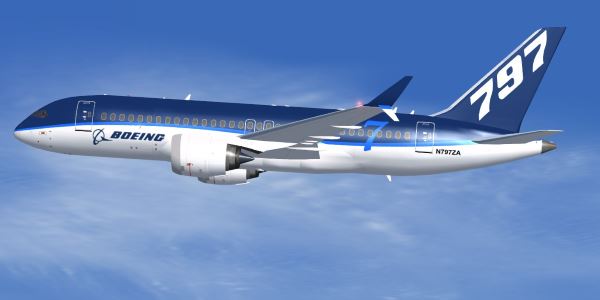Leeham News and Analysis
There's more to real news than a news release.
The data behind Emirates’ choice of 787-10
By Bjorn Fehrm
Subscription Required
Introduction
November 16, 2017, © Leeham Co.: Yesterday we outlined the qualitative reasons why the Boeing 787-10 was selected for Emirates’ medium-range routes. Now we put figures behind the words.
We will quantify the weight and drag consequences of the tighter packaging of the 787 and discuss what it’s smaller wing means in field performance from a hot Dubai International Airport.
We use our airline performance model to give us the data, flying the aircraft over typical routes.
Summary:
- The A350-900 was designed for flights up to 15 to 20 hours.
- To make these bearable, Airbus decided to offer 18-inch seat width in the nine abreast economy cabin.
- Boeing went another route. It offered a slightly narrower fuselage and let the airlines decide between eight or nine abreast economy.
- Only Japanse ANA and JAL chose the base layout with eight abreast economy (and ANA has since switched to nine abreast economy for new deliveries).
- The result is an aircraft with lower empty weight and fuel burn (everything else being equal).
- For the 787-10, Boeing combined the tighter packaged fuselage with a wing optimised for flights up to 12 hours.
- The 787-10 consequently beats the A350-900 on efficiency for shorter routes.
Airbus’ A330 or Boeing’s 787 for LCC long haul?
By Bjorn Fehrm
Subscription Required
Introduction
November 09, 2017, © Leeham Co.: International Airlines Group’s (IAG) CEO, Willy Walsh, said in an Investor presentation last week “LEVEL (the group’s Long Haul LCC) is as well off with the Airbus A330-200 as with a Boeing 787.” He said the lower capital costs of the A330 compensates for the Dreamliner’s lower fuel burn.
As a proof, Walsh said IAG had run flight plans with their LEVEL A330 flying the same mission as a Norwegian 787 and configured as the Norwegian aircraft. The difference in fuel burn Barcelona-Los Angeles would be 6t. But this is easily compensated by the difference in capital costs. Going forward, LEVEL has the possibility to switch to the 787, said Walsh. Our reaction is; why not include the A330neo in this discussion?
Going forward, LEVEL has the possibility to switch to the 787, said Walsh. Our reaction is; why not include the A330neo in this discussion?
We decided to verify Walsh statements and also check why an A330neo wouldn’t be more appropriate than a 787.
Summary:
- The statement by Walsh about the difference in fuel burn between the A330 and the Dreamliner is correct.
- However, fuel cost is no longer the dominant cost in airline operations.
- We compare the total Cash Operating Costs (COCs) of the aircraft, then we view whether the COC difference between the types can be compensated with capital cost differences.
Singapore airlines increases order for 787-10
By Bjorn Fehrm
Subscription Required
Introduction
Oct. 26, 2017, © Leeham Co.: Singapore airlines increased its order for Boeing’s 787-10 from 20 to 39 this week. The first aircraft for the airline rolled off the assembly earlier this month. It will now be prepared for delivery, flying out to Singapore on the new year.
The 787-10 is essentially a 787-9 which can take more passengers. By it, the cost per passenger goes down.
How much better? By comparing with the closest competitor, Airbus A350-900, we can learn by how much.
We will use our performance model to compare the aircraft. It’s a bit apples and oranges, because the A350-900 is a long-range airliner with 8,000nm range, and the 787-10 sacrifices the range of the -9 variant to carry more passengers.
But it’s interesting to see how this sacrifice pays off in efficiency on the type of routes the 787-10 was designed for.
Summary:
- The 787-10 is optimized to carry 330 passengers out to 6,400nm. It does this with a well-packaged fuselage and the wing of the smaller 787-9.
- The A350-900 is larger. It has a larger wing, to fly longer. And its fuselage diameter brings more passenger comfort, especially in economy.
- With both built with weight-saving carbon fiber technology, it’s not surprising the 787-10 is lighter, despite holding a row more of passengers.
- Weight and size always cost fuel. The difference in fuel burn is consistent with the difference in aircraft capabilities.
Trump decertifies Iran nuke deal, throws Airbus, Boeing orders in doubt
Subscription Required
Introduction
Oct. 16, 2017, © Leeham Co.: President Donald Trump announced Friday he will decertify the Iran nuclear deal, throwing into doubt a host of related commercial deals, including huge aircraft orders.

Iran Air Airbus A330. Photo via Google.
Trump hasn’t gone so far as to withdraw from the pact, but he still threatens to do so unless Congress makes changes he wants.
Here in the US, focus is, of course, on the commitment by Iran for Boeing aircraft—none of which are firm contracts, but “commitments” to order.
Of less focus here, if any, is on the outstanding orders placed by Iran for Airbus and ATR aircraft, which are subject to US licensing.
Summary
- 30 Boeing 777s, including 15 Classics are at stake.
- 50 Boeing 737 MAXes to Iran Air and 30 to Iran Asesman are also at stake.
- ATR has 11 aircraft scheduled for delivery in 2018.
- Airbus sold 114 A320s/321s, A330s and A350s to Iran Air. A few white tails already have been delivered.
Boeing’s Bold Ambition, Part 2
Subscription Required
Introduction
Oct. 9, 2017, © Leeham Co.: When Boeing launched the 787 program in 2003, an after-market maintenance program called Gold Care followed.
It wasn’t successful. Few customers signed up for it.

Stan Deal, CEO of Boeing Global Services.
But the lessons learned are important for Boeing’s drive to vastly expand its presence in the global commercial airplane after-market business.
Boeing Commercial Airplanes and Boeing Defense, Space & Security (and the latter’s predecessor, Integrated Defense Systems) provided services to the airlines, lessors and government customers, but now there is a dedicated business unit.
Boeing Global Services was announced nearly one year ago, on Nov. 21. When Boeing reports its third quarter earnings at the end of this month, for the first time revenues and profits for BGS and its predecessors will be a line-item in the earnings statements.
Stan Deal, the CEO of BGS, acknowledged the poor start of Gold Care in an interview with LNC. But from this unhappy experience, Boeing learned what officials hope lays the foundation of a new, robust business.
Summary
- 787 Gold Care didn’t start out well.
- Gold Care is rejigged and rebranded.
- BGS services Airbus aircraft, too.
Airbus preparing to hike A350 production rate
Subscription Required
Introduction
Oct. 5, 2017, © Leeham Co.: Airbus is gearing up to increase the production rate of the A350 from 2018’s planned 10/mo to 13/mo, perhaps as early as the following year, LNC has learned.
year, LNC has learned.
The move follows Boeing’s announcement in September that it will increase the production of the 787 from the current 12/mo to 14/mo in 2019.
Airbus is producing the A330 at a rate of 6/mo.






